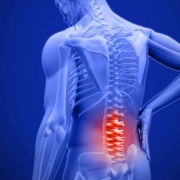Sciatica
The Sciatic Nerve is the largest nerve in the body.
It consists of a large bundle of small nerves that begin in the lumbar spine, travels down the buttocks and moves through the leg. Radiating pain is one of the more common and intense symptoms associated with sciatica with numbness and tingling starting in the lower back and radiating down the leg all the way to the foot.
Sciatica occurs when a muscle, a spinal disc, and sometimes even the spine itself pushes on the sciatic nerve.
A spinal disc herniation, often referred to as a slipped disc, occurs when a small portion of the spinal disc bulges out of the spinal column. The disc then pushes on the sciatic nerve causing pain. Spinal stenosis, or narrowing of the spinal canal, could also push on the nerve and cause pain. Muscle spasms can also cause sciatica. Most of the time it is the piriformis muscle, but occasionally it can be other muscles in the lower back and pelvic region, that pushes on the sciatic nerve causing pain.
Physical therapy and rehabilitation, including exercises to help your posture and strengthen your muscles, is one Western method that is effective. Prescription drugs such as anti-inflammatory medication, muscle relaxants, narcotics, antidepressants and anticonvulsant drugs are also used. Injections or surgery are other possible options, though often recommended as a “last resort”.
Acupuncture Theory holds the view that sciatica is caused by blockages of Qi and blood in the back channels. This blockage causes imbalances in the body that expresses itself as pain and a burning sensation along several channels on the lower back and down the leg. Unlike many Western methods of treating sciatica, which treats the symptoms or masks the condition, acupuncture corrects the root of the problem by eliminating those blockages and encouraging self-healing of the body.
Sciatica is always a result of the inability of the bodies healing energy to flow into the back, which can lead to inflammation and degeneration.
Some common imbalances involved in sciatica are:
- Kidney Qi deficiency, which involves your back feeling very weak and not getting better, even with a lot of rest.
- Spleen Qi deficiency with dampness, which involves fatigue, weakness and heaviness though the back does feel better with rest.
- Liver Qi stagnation, which involves muscles that are very tight and in spasm, particularly when you become angry, frustrated or have a lot of stress in your life.
Acupuncture treatments will correct the imbalances listed above and allow the healing power of the body to flow through the areas of pain. In essence, this allows the body to heal itself.
There are many natural remedies that may help sciatica including cold packs and/or hot packs. Stretching exercises for your low back may help relieve nerve root compression, and over-the-counter medications may help to reduce pain and inflammation. Regular exercise such as water aerobics or other low-impact exercises may help strengthen the core stability and limit the effects of the problem.
We have had many patients with sciatic pain come to our clinic.
One patient came in with excruciating pain. Unable to sleep and in intense pain 24 hours a day, he stated that he had tried everything to get rid of it. With the correct placement of needles, his pain was reduced by 50% during his first treatment. By the end of the seventh treatment he had no more pain and felt great. While not everyone has this quick of a response, most people receive relief after a few treatments.
Acupuncture is a gentle treatment that is very effective in treating sciatic pain.
It is relaxing, restorative and balancing. Allowing the foundational energy of the body to flow freely and easily, acupuncture allows the healing power of the body to eliminate pain and correct the root of the problem. Acupuncture is a very safe and natural option for sciatic pain.
Kurt Redmond
Acupuncturist St. George
Vision Acupuncture Specialist
435.359.1479
Find Energetic Health on Facebook






Leave a Reply
Want to join the discussion?Feel free to contribute!